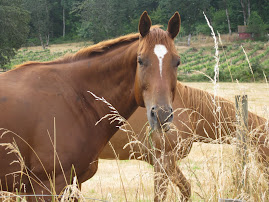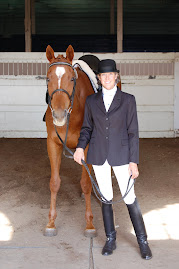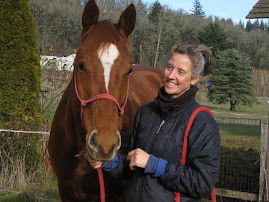When did it become acceptable to use the lunge line as way to let your horse be a moron because they have "get their energy out?" ??????
IT doesn't make sense to allow your horse do to WHATEVER it wants in circles around you, then expect him/her to BEHAVE when you handle or ride him/her. ?????????
The things I see people do with their horses on the lunge line is
One. Of. My. Pet. Peeves.
Does it show??
Any time you are with your horse, your are TRAINING your horse how to respond to you. Whether it is feeding time, blanket time, turn-out time...the list goes on, it is YOUR JOB to be the Alpha of the herd - no Ifs, Ands, or Butts! about it.
Yet, there is still this idea that the paces people put their horses through on the lunge line somehow do not apply.
IT IS ALL TRAINING.
With that in mind - Re-Think your expectations on the lunge line. It is YOUR time with your horse, Sooooooooooooooooo...turn that session on the lunge line towards YOUR benefit, and eventually the horse's.
When Trevor was towards the end of his official recovery time from colic surgey (three months), I did not want to hop on an expect him to be rideable. So, I lunged him. Since he was still in a muscle-building recovery mode, he did not have the options to be a moron on the lunge line. With weak belly muscles, no topline, no hindquarters, the last thing I wanted him to do was compromise his already delicate muscle structure. Granted - I used the lunge line from a "working" point-of-view before, I just re-defined the expectations.
My re-defined expectation was that the lunge line was a) the horse's job for that session b) RELAXATION.
Yes - I was able to teach my horse to RELAX while lunging.
You can, too!
Began your lunge session with the horse at a walk. Re-direct any behavior that isn't consistent with a walk (that! is usually pretty obvious...). Then, the horse's job is to walk until he/she chews. Now - this could take a while with an uptight horse still learning the art of relaxation, so give you and your horse that time. When you do get the "chew," change directions AT THE WALK! and do the same thing the other way. It may be that your first few sessions are at the walk only, but don't fret! The expectation of something, anything!, new to a horse takes sometime to learn.
When you get the chew in both directions, then do the SAME THING at the trot. Wait for the chew on the lunge line, ask for the walk, and then change direction.
A note for the TROT - to help your horse fine the relax and chew, ask him/her to SLOW the Trot down. A horse trotting a million miles an hour will have great difficulty finding a space to relax. Not only does slowing the trot down help your horse relax, it helps your horse find a RHYTHM. Rhythm is a key element in any successful horse and rider combination. Have the expectation of relax and rhythm.
When you get the chew in both directions, then do the SAME THING at the canter.
As the canter can be a difficult gait for the green and/or unbalanced horse, be a bit more forgiving (only in the gait, not in attitude!). I look for other signs of relaxation in the canter due to it's three beat nature. Trevor tends to "blow" when he is relaxing in the canter and then chew after the down transition to the trot. Help the horse to find the rhythm, give the horse trot breaks and get the chew in the trot before asking for the canter again.
Another kudo that happens when you lunge for the chew and relaxation is the
S T R E T C H Over the topline.
Some horses naturally do this, others need help. Encourage your horse ANYTIME he/she offers to lower his/her head. It can start small, but soon they learn that it is nice to stretch down and move those back muscles. It then becomes a good indicator of how relaxed horse is that day.
So! RE-THINK! the lunge line and create a new way to play with your horse.
Wednesday, February 15, 2012
Subscribe to:
Post Comments (Atom)




No comments:
Post a Comment